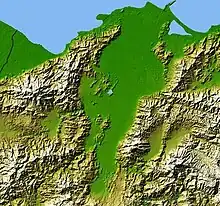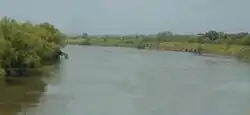
The Valley of Sula (also, Sula Valley) is the largest alluvial valley of Honduras. It is located in the northwest of the country, and within it lie several of Honduras's most important cities, such as San Pedro Sula, El Progreso, Choloma, Puerto Cortés, Villanueva, and Tela.
Hydrologically speaking, the area has two of the most important basins of Honduras: the basins of the Ulúa and Chamelecón rivers, leaving the area vulnerable to flooding, mainly in the rainy season.
The valley's ecosystem is mainly composed of tropical dry forests.
Economy

The valley's fertile soils have boosted its agricultural development.
Around 65% of the Gross domestic product of Honduras is generated in the valley, representing over 50% of the country's exports. Within it resides roughly 30% of the national population, due to the high concentration of the workforce, both in urban and rural communities.
Municipalities of the Sula Valley
| Municipality | Department | Population | Area |
|---|---|---|---|
| San Pedro Sula | Cortés | 801,259 | 856 km2 |
| Choloma | Cortés | 275,724 | 467 km2 |
| Villanueva | Cortés | 177,699 | 349 km2 |
| Puerto Cortés | Cortés | 136,081 | 383 km2 |
| Santa Cruz de Yojoa | Cortés | 92,746 | 734 km2 |
| La Lima | Cortés | 84,102 | 112 km2 |
| San Manuel | Cortés | 68,435 | 141 km2 |
| Omoa | Cortés | 53,771 | 394 km2 |
| Potrerillos | Cortés | 25,960 | 99.4 km2 |
| San Francisco de Yojoa | Cortés | 24,740 | 98.7 km2 |
| San Antonio de Cortés | Cortés | 22,884 | 221 km2 |
| Pimienta | Cortés | 21,975 | 55.4 km2 |
| El Progreso | Yoro | 200,010 | 534 km2 |
| El Negrito | Yoro | 49,196 | 565 km2 |
| Santa Rita | Yoro | 21,208 | 129 km2 |
| Quimistán | Santa Bárbara | 60,047 | 745.3 km2 |
| Petoa | Santa Bárbara | 12,000 | 213 km2 |
| Tela | Atlántida | 106,136 | 1156 km2 |
| Total | Valley of Sula | 2,033,365 | 7,384.6 km2 |
See also
References
- "Contexto geográfico | ZMVS". www.zmvs.org (in European Spanish). Retrieved 12 February 2017.
External links
- "Valle de Sula, Honduras - Geographical Names, map, geographic coordinates". www.geographic.org.